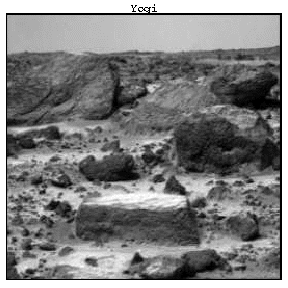Introduction
Matrix Action
Perpframes, Aligners and Hangers
Stretchers
Coordinates
Projections
SVD
Matrix Subspaces
Linear Systems, Pseudo-Inverse
Condition Number
Matrix Norm, Rank One
Data Compression
Noise Filtering
Todd Will
UW-La Crosse
Image compression
"Numerical Methods and Software", Prentice-Hall, 1989:
"Suppose that a satellite in space is taking photographs of Jupiter to be sent back to earth.
The satellite digitizes the picture by subdividing it into tiny squares called pixels or picture elements.
Each pixel is represented by a single number that records the average light intensity in that square.
If each photograph were divided into 500 x 500 pixels, it would have to send 250,000 numbers to earth for each picture.
This would take a great deal of time and would limit the number of photographs that could be transmitted.
It [is sometimes] possible to approximate this matrix with a matrix which requires less storage."
Yogi
Here's a Martian image of a rock called "Yogi" sent back by the Sojourner rover.The image is stored as a 256 x 264 matrix M with entries between 0 and 1.
![[Graphics:compressiongr1.gif]](compressiongr1.gif)
The matrix M has rank 256.
Here's a plot of the singular values for M.
![[Graphics:compressiongr3.gif]](compressiongr3.gif)
Since the singular values are decaying so rapidly, you can expect that there will be a good lower rank approximation to M.
That is, for a relatively small k, you should have
Have a look at various lower rank approximations to M.
What's the advantage of using a lower rank approximation for M?
To send the matrix M you need to send 256 x 264 = 67584 numbers.
To send the rank 36 approximation to M you need only send
-
the first 36 singular values,
-
the first 36 hanger vectors, each of which has 256 entries,
- the first 36 aligner vectors, each of which has 264 entries.
So in total you need to send only 36(1+256+264)=18756 numbers.
